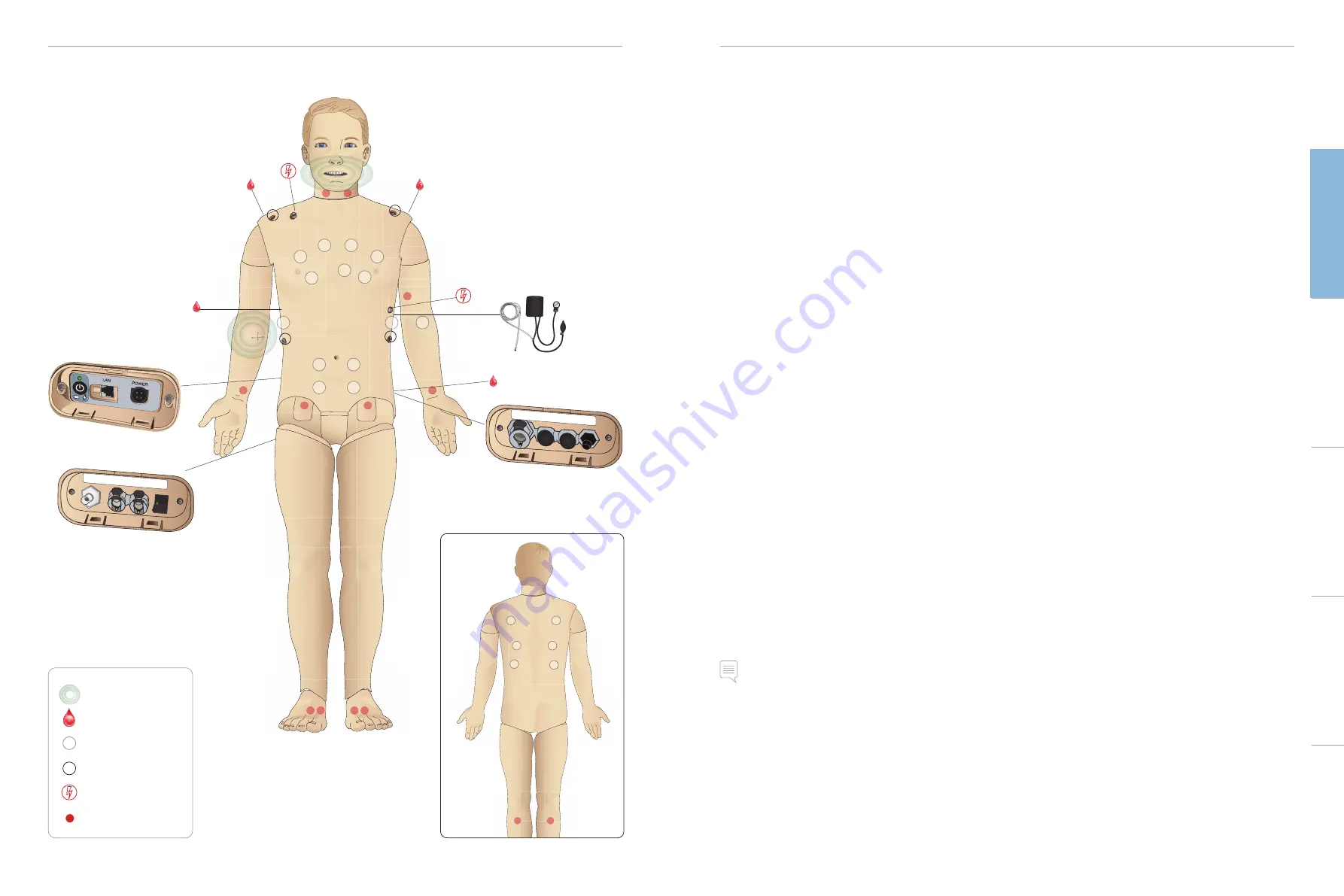
6
7
FEATURES
FEATURES
General
Main Anatomical Features
Dimensions (Patient Simulator only):
1800mm (l) x 550mm (w) chest (5. 90 ft x 1.80 ft)
Weight (Patient Simulator only): 38.5kg (85 lbs)
Weight (with clothes): 40 Kg (88 lbs)
Default male body with interchangeable genitalia pads
Configurable Anatomical Features
Genitalia
The Patient Simulator comes with a neutral genitalia pad as default.
The pad can be changed for a male or female module, both included
with the SimMan 3G System.
See Changing the Genitalia Modules
section
.
Teeth
Patient Simulator comes with a set of soft teeth as default. These can
be exchanged for a hard set of teeth, included with the
SimMan 3G
System.
See Changing upper dentures
section
.
Trauma Modules/Limbs
Left leg - amputation and bleeding module (optional accessory).
Right arm - amputation and bleeding module (optional accessory)
The SimMan 3G arm adaptor kit is used to connect the trauma arm
modules.
Contact your local Laerdal representative to enquire about other
trauma modules compatible with
SimMan 3G
.
Mobility of Joints
Neck:
Movement can be on a 3-axis movement of head.
Range of movement can be restricted.
See Airway
Features
section
.
Shoulders:
3-axis rotation
Lumbar:
1-axis
Elbows:
Fixed, no mobility
Wrists:
3-axis rotation
Thumbs:
Free mobility
Hip joints:
3-axis rotation
Knees:
1-axis rotation
Ankles:
1-axis rotation
Note: Do not remove protective bushings at shoulder or lower back.
These are present to protect users from pinch points.
Laerdal Simulation Software
To run a simulation, LLEAP (Laerdal Learning Application) must be
started from Laerdal Simulation Home on the Instructor PC.
Laerdal Simulation Home
Laerdal Simulation Home is an application from where LLEAP and
other Laerdal programs related to patient simulation can be found
and started. Also the help files can be opened from here. Laerdal
Simulation Home is located in the Laerdal Medical folder under the
Windows start menu (Windows 7).
Software used in a simulation session comprises the following main
applications:
−
LLEAP (Laerdal Learning Application)
−
Voice Conference Application
−
Patient Monitor
−
SimView Server or Session Viewer
SimDesigner and other applications are also used for designing or
preparing a simulation.
LLEAP
LLEAP is the instructor’s application from where the simulation
session is run, controlled and monitored. LLEAP can be operated
in Automatic or Manual mode. Automatic mode is used for
pre-programmed scenarios while Manual mode allows the instructor
full manual control of the simulation session. Running simulations in
Manual Mode requires some medical expertise to create clinically
sound simulations.
Voice Conference Application
The VCA software allows the instructor to communicate through
the simulator during the session. VCA can also be used to
communicate with other instructors on a network, and create
separate channels where only members can communicate.
Patient Monitor
The Patient Monitor application emulates a typical hospital patient
monitor. It is the learner’s console and can be set up and controlled
by the instructor, as well as by the learner through on-screen touch
menus.
Session Viewer and SimView Server
Session Viewer and SimView Server are applications that record
video and patient monitor screen captures during simulation, in
addition to providing an interface to debrief your session. After a
session is ended, log files generated in LLEAP are transferred and
merged with the video files in Session Viewer or SimView Server for
the debrief.
Session Viewer typically runs locally on the same computer as used
for LLEAP, SimView Server runs on a dedicated server in the local
network. During the first start-up of LLEAP, you are prompted to
select a debriefing system available on your computer or on a local
network. This can be changed later.
SimMan 3G Overview
Power Panel
Fluid Fill Panel
DC Input 9-24V X, XA
Fluid
Inlet
Air Out
Blood
Inlet
Activate
Filling
RFID Antennae
Bleeding ports
Speakers
ECG Connectors
Defib Connectors
Pulses
Cautions
and
W
arnings
Featur
es
Setup
Maintenance
Spar
e Par
ts
Tr
oubleshooting
Air/CO
2
Panel
Air / CO
2
Inlet
Blood
Outlet



















